Ornamental shrub with flowers. Shearing topiary plants. Trimming decorative deciduous shrubs
For a novice gardener, this problem is one of the most painful. How to cut? When to cut? How much to cut? There are so many plants, they are all so different ... At some point it may seem that you will never master this wisdom.
In fact, everything is not as difficult as it seems. After several years of gardening, you will intuitively begin to understand how the pruning of a plant depends on the time of its flowering, growth and branching characteristics.
Of course, experimenting for years is not necessary at all. You can open the book and find out everything at once. But here's the problem: we have a problem with good literature on this subject. One book will reasonably explain to you how to prune summer-blooming and spring-blooming spireas. From the other you will learn how to cut turf. But building a coherent and logical system on the basis of this fragmentary information is very difficult.
At one time, I bought up everything in a row books in Russian and English, on the covers of which it was written: "Trimming ..." And finally, I found what I was looking for. It was the English edition: `Successful Pruning`. I flipped through it, and everything somehow immediately fit into my head.
Today we offer you an adapted translation of this edition. Not the whole book, of course. But what seems to us the most important. We offer you a slender and intelligible, as it seems to us, trimming system ornamental shrubs.
Actually, the whole system comes down to nine trimming techniques, which will be outlined below.
TECHNIQUE 1. CUT FOR SHAPE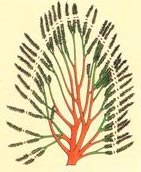
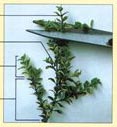 This technique is used for shrubs that are grown in molded hedges and require constant pruning.
This technique is used for shrubs that are grown in molded hedges and require constant pruning.
So: if you form a hedge in the spring, you only remove the growth previous year. If you prefer a haircut in the second half of summer, you delete, respectively, the growth of the current year. You may have to do both spring and summer pruning if you are dealing with fast growing plants.
Formative pruning will help you keep the plant neat and compact - in the desired size and shape. And remember: once you have applied this type of pruning, it is advisable to do the same every year.
Note: small plants can be cut with scissors or electric trimmer. For large ones, you need to use a pruner, as damaged leaves and stumps left from the shoots will turn brown and die.
(For more information on pruning hedges, see the articles on our website.)
According to technique 1, the following are cut: hedges of barberry, privet, hawthorn, honeysuckle, cotoneaster, snowberry.
Salix lantana is always recommended to trim using technique 1 to maintain its shape.
TECHNIQUE 2: REMOVING THE NEW GROWTH IN HALF
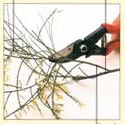 Do not let broom and other gorse bushes spread wide and expose the base. Cut new growth by half every year. Start doing this when the plant is still young. If a few years for pruning are missed, in the future, young shoots will grow, falling down from the old coarsened branches, which will drastically reduce the decorative effect of the shrub. Trim off any new green shoots to encourage new branches and growth. Do not cut to old rough wood. Remove dead branches completely.
Do not let broom and other gorse bushes spread wide and expose the base. Cut new growth by half every year. Start doing this when the plant is still young. If a few years for pruning are missed, in the future, young shoots will grow, falling down from the old coarsened branches, which will drastically reduce the decorative effect of the shrub. Trim off any new green shoots to encourage new branches and growth. Do not cut to old rough wood. Remove dead branches completely.
After pruning, the bush will look more elegant and compact.
Trim gorse-type shrubs after the flowers have faded but before the seeds have matured.
According to technique 2, they are cut: Russian broom, creeping broom, English gorse.
TECHNIQUE 3. CUTTING DEAD ENDS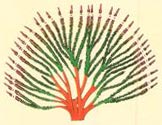
 Trim heathers and other similar plants, removing dead shoot tips with scissors. This will help the plant to be lean and compact and stimulate its flowering.
Trim heathers and other similar plants, removing dead shoot tips with scissors. This will help the plant to be lean and compact and stimulate its flowering.
As soon as the flowers begin to die off, remove them with scissors. With pruning fall-flowering heathers, wait until spring.
Remove shoots close to the base of the current year's growth. Do not cut to old dark wood.
By technique 3 they shave: heathers, almost all erics.
TECHNIQUE 4. SHORTENING SIDE BRANCHES![]()
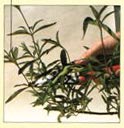 We are talking about shrubs that bloom on the shoots of the previous year. As a rule, these are summer-flowering shrubs. Pruning on such shrubs stimulates the growth of a large number of side branches and more abundant flowering. It is necessary to cut the shoots one third from the top to well-developed buds immediately after flowering. (Hydrangea paniculata can be cut and in early spring if you want to admire its powerful inflorescences in winter).
We are talking about shrubs that bloom on the shoots of the previous year. As a rule, these are summer-flowering shrubs. Pruning on such shrubs stimulates the growth of a large number of side branches and more abundant flowering. It is necessary to cut the shoots one third from the top to well-developed buds immediately after flowering. (Hydrangea paniculata can be cut and in early spring if you want to admire its powerful inflorescences in winter).
After pruning, the plant will not look significantly increased in growth compared to last year. But it will become more compact, and flowering next year will be more abundant.
According to technique 4, they are cut: hawthorns, panicled hydrangea, rose rugosa (if you grow it not for the sake of fruits, but for the sake of flowering), erica tree. The latter should be cut not by a third, but by two-thirds of the shoot.
TECHNIQUE 5. REMOVING ONE STEM OUT OF THREE.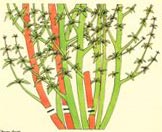 A large number of shrubs that produce many new shoots every year will look healthy and beautiful if you cut one shoot out of three each year. This very common technique avoids overcrowding and encourages flowering on strong shoots.
A large number of shrubs that produce many new shoots every year will look healthy and beautiful if you cut one shoot out of three each year. This very common technique avoids overcrowding and encourages flowering on strong shoots.
The technique is applied to three groups of bushes:
- Those that bloom early on the shoots of the previous year (forsythia, spiral vanguta, ornamental currants)
- Those that bloom profusely throughout almost the entire summer (shrub cinquefoil).
- To some shrubs that are grown for their beautiful foliage (white turf "Elegantissimo").
This type of pruning should begin when the shrub reaches the age of three. And if every year after that you cut one branch out of three, the shrub will look strong and compact at the same time.
Remove one stem out of three, cutting it as close to the ground as possible. First of all, choose the weakest and oldest branches.
After all old and weakened branches have been removed, remove those that extend far from the center of the bush and break the shape of the plant. If you do not see a bud near the ground from which a new shoot can come, leave a short stem with a bud. Subsequently, you can delete this branch as well, when there is enough new growth to replace it.
After pruning, the shrub may look somewhat sparse. But soon new shoots will appear that will fill the space.
According to technique 5, they are cut: a significant part of the shrubs, if they need to be formed as tapeworms, and not for a hedge. Among them are barberries, cotoneasters, hazel, action, white derain "Elegantissimo", colquitsia, honeysuckle, sea buckthorn, mahonia, weigela, snowberry, stefanander tanaki, mock orange, sucker, ornamental currants, forsythia, cinquefoil, lilacs (with a small caveat: remove you need not one of three, but one of four shoots), elderberry (if it is necessary to stimulate not the growth of foliage, but flowering and fruiting); spireas - arguta, vangut, thunberg, nipponika, Japanese - Bumalda and Shirobana, viburnum (if you want to keep the bush more compact).
Please note: shrubs that bloom in early spring should be cut only after they have faded. Summer flowering shrubs can be cut in early spring.
TECHNIQUE 6. CUT TO THE GROUND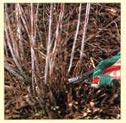 Use this technique to cultivate, improve the development of plants that throw out a large number of strong-growing twigs (such as sweet raspberries).
Use this technique to cultivate, improve the development of plants that throw out a large number of strong-growing twigs (such as sweet raspberries).
Some shrubs, such as ornamental raspberries, produce many new shoots each year. Old branches are best cut in early spring to ground level.
Such pruning is also used in cases where, in plants growing like raspberries, young shoots have decorative coloring. Let's say Rubus cockburnianus has young shoots. white color. With age, their color changes and becomes less interesting. It is advisable to cut such a plant annually to ground level.
When pruning such plants, you do not have to worry about making a cut on a bud that you can see. Young shoots will come directly from the ground.
According to technique 6, they are cut: decorative raspberries, stefanander inquis, bicolor lespedeza.
TECHNIQUE 7. CUT TO THE BASE OF THE BUSH (A)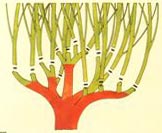 Plants that are grown for their beautifully colored shoots, such as Derain White, will look more attractive if they are regularly pruned 2 inches from the base of the bush to encourage new shoot growth.
Plants that are grown for their beautifully colored shoots, such as Derain White, will look more attractive if they are regularly pruned 2 inches from the base of the bush to encourage new shoot growth.
The same technique is necessary in order to stimulate the growth of large ornamental leaves, such as yellow-leaved elderberry.
Let the plant grow a season after planting, and then cut back the following spring to a height of 5-7 cm from the ground.
We do not recommend cutting plants in this way every year: if the shrub is not well fed or poorly mulched, it will only be able to throw out weakened thin stems. But pruning to the base every second year is just what you need. It will promote the growth of strong thick stems, and the plant will not need intensive feeding.
Technique 7 cuts: turf with decorative bark and decorative leaves, willows with decorative bark, elderberry - if it is grown for the sake of beautiful leaves.
TECHNIQUE 8. CUT TO THE BASE OF THE BUSH (B)
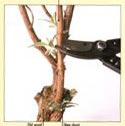 The technique is exactly the same as the previous one. But pruning should be done in the very first spring after planting and is required every year without fail. Buddleia and other shrubs that bloom on current season shoots (such as Hydrangea arborescens) will produce larger flowers on more compact plants if you cut the plant back 5-7 cm from the base of the bush each spring. If this is not done, the plants will produce smaller flowers on ankle-length, outstretched branches.
The technique is exactly the same as the previous one. But pruning should be done in the very first spring after planting and is required every year without fail. Buddleia and other shrubs that bloom on current season shoots (such as Hydrangea arborescens) will produce larger flowers on more compact plants if you cut the plant back 5-7 cm from the base of the bush each spring. If this is not done, the plants will produce smaller flowers on ankle-length, outstretched branches.
Cut off all last year's growth, leaving 2 buds at the base. This is usually 5-7 cm on last year's shoots.
If the bush has grown to a very large size and is full of shoots, cut one or two old stems to ground level. This will allow the plant to conserve energy for better flowering and get rid of poorly placed branches.
After pruning, many bushes can throw out shoots up to one and a half meters or more per season.
The same technique is applicable in the case of dwarf Japanese spireas. By cutting them to the base of a bush, you kill several birds with one stone: you create growth conditions for new strong stems, form a compact, beautifully shaped shrub, and in the case of yellow-leaved spireas, you promote the growth of brighter and more expressive foliage.
According to technique 8, they are cut: buddley, tree hydrangea, spirea "Little Princesses", "Golden Princesses", "Gold Mound", "Nana" and the like.
TECHNIQUE 9. CUTTING GRAY LEAVED PLANTS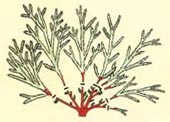
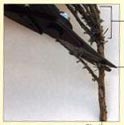 Regular pruning of plants such as lavender, perovski helps to create the correct compact form. Start cutting the plant while it is young. If you first resort to a strong pruning of an adult plant and cut into old wood, the shrub can be very weakened and even die. Prune regularly every spring.
Regular pruning of plants such as lavender, perovski helps to create the correct compact form. Start cutting the plant while it is young. If you first resort to a strong pruning of an adult plant and cut into old wood, the shrub can be very weakened and even die. Prune regularly every spring.
If the growth of the current year comes directly from the base of the bush, cut the plant 5-10 cm from the ground.
With a mature plant with a lignified base that does not have young shoots coming from the ground, be careful. Do not cut into old dark wood. Get by with pruning the previous year's soft shoots 5-10 cm from the old dark wood.
According to technique 9, they are cut: lavender, perovski.
Here, in fact, is all the wisdom.
Of course, this scheme needs to be approached creatively. If we plant a shrub, which is usually pruned using technique 5 (one out of three shoots is removed), has grown strongly, lost its attractive shape and began to bloom worse, it can be radically planted on a stump using technique 8 and thereby rejuvenate. If the tips of a shrub that is cut using the same technique 5 are frozen, you still have to not only remove one shoot out of three, but also walk with a pruner along the tips of the frozen twigs. For example, I don’t really like it when my Goldfinger and Tangerine cinquefoils fall apart into somewhat shapeless bushes, and therefore every spring I cut them like gorse - half the growth of last year. In the same way, and with the same goals, I cut the summer-flowering spireas of Bumld and Shiroban. Or, for example, panicled hydrangea. Sometimes you cut it not by a third of the shoot, but much more - in search of a good pair of buds and a beautiful shrub habit as a whole.
In short, it is quite acceptable to deviate from the rules if you know these rules well and perfectly understand why you are doing this or that movement with a pruner.
And finally: any pruning technique must be combined with sanitary pruning - remove all diseased, broken, crooked, weakened branches. But this is already quite simple ...
Good luck cutting!
Irina SAVVATEEVA, General Director of the Savvateev Nursery
Plot owners, especially beginners, usually pay a lot of attention to the nutrition and composition of the soil, top dressing and watering. And, alas, they often forget about pruning shrubs. Some even believe that it is not needed at all. However, over time, when the bushes gain strength and grow many additional branches, the understanding comes that pruning is simply necessary.
Often there is not enough knowledge on the features of pruning ornamental shrubs. How to cut, when and how much? There are a huge number of plants, and they are all so different ... At some point, it may seem that you will never master this wisdom. Don't worry, our issue will help both novice gardeners and experienced owners. household plots take a fresh look at the need for crown formation, learn pruning techniques and learn about its intricacies for various kinds plants.
Should shrubs be trimmed?
The answer is unequivocal: not only necessary, even necessary. Pruning greatly affects all the life processes of the shrub. However, the main principle in this matter is to do no harm. And starting work, you should clearly understand what you will cut and why. First of all, this procedure will help to improve the plants - such pruning is called sanitary. Pruning is also necessary to regulate growth, as well as to form fruits.
And there are many ways to achieve the desired result. Intervention in the growth of the crown is simply necessary for the rejuvenation of shrubs. No matter how we maintain the bush in good condition, all plants grow old, their beauty and shape are lost, development slows down.
And if everything is done correctly, it will help to return the former appearance to your favorite variety of lilac, mock orange, spirea ... The aesthetic side is also important in this matter. Crown shearing will give the plant the desired size and shape of the crown, sometimes very far from natural. This pruning is called topiary art. And most simple tricks every gardener can master. Such pruning often needs to be started from the first days of a plant’s life in the garden in order to “accustom” it to a constant haircut, and not shock it, because this can destroy the bush. In the future, they maintain the shape so that the plant retains its “hairstyle”. Otherwise, it will seek to return natural look. However, after the intervention, this plant will not succeed fully.
Pruning: terms
Cutting, or thinning.
This is the complete removal of a branch or shoot. In shrubs, branches are removed as close as possible to the soil surface or even below its level. Small branches are cut with secateurs, large ones are cut out.
Trimming "for translation".
This technique is used on perennial wood. On the shoot, a suitable branch is chosen - younger and directed in the right direction. The cut is made without stumps.
Cutting or shortening.
When pruning, the length of a branch or shoot is reduced. It is needed to stimulate branching. The stronger the shortening, the more new shoots are then formed. One-year growth is cut off on a kidney directed in the right direction.
How to cut and shape the crown - some subtleties
Pruning any shrub helps to emphasize the dignity, individuality, make it more expressive and neat. Remember the main points.
The shoots that will make up the bush, young plant appear from the buds located on the basal part of the stem. Therefore, when planting a seedling (it does not matter - one-, two- or three-year-old), the root neck should be deepened by about 5-8 cm.
Most shrubs are strong growing. The height of adult plants is more than 2 m (viburnum), and sometimes even 5 m (irga). And so that they begin to bush, when planting, their shoots are shortened. The longest and most well-developed branches are roughly equal in length with the rest. The broken ones are cut off to the first normal kidney, and the sick and weak ones are cut out completely.
If you see that by the end of the season the shoot has not matured, in the fall it is better to cut it to the mature part of the wood. Otherwise, it will most likely freeze in winter. If in doubt, you can leave the shoot to winter and in the spring cut out the part on which the buds have not blossomed (the dead top).
Saplings of low shrubs (the height of adult specimens is up to 1.5 m) immediately after planting are cut so that only stumps with two or three buds remain from each shoot. In the spring, strong shoots sprouted from them will develop well and help the plant grow the root system faster. If not pruned, only a small length and thickness of the shoot will grow from each awakened bud, since root system seedlings are still underdeveloped.
Acting appropriately is also important.
Shrubs need to be pruned annually. If you do this from case to case, haphazardly, the crown will thicken greatly. Pests love to settle in this, and diseases will more often affect shrubs.
If the bush is already running, but you don’t want to throw it away, you can try to improve its crown. Of course, in such a situation, many shoots will have to be removed.
It is important to do this not in one year - take pity on the plant and stretch the work for two, but preferably three seasons. And don't wait excellent results immediately, and such pruning never fully compensates for the shortcomings of care.
In the practice of many gardeners, there is a common mistake - to wait until the plant becomes an adult. And only then do they begin to think about the need to trim it. But, having lost time, it becomes very difficult to form a beautiful crown - changing the shape takes years, and sometimes it is already impossible to do.
Important!
The distance between the buds on the branches and the cut is very important. If cut too close, the buds can stop growing and dry out. If, on the contrary, far from the kidney, you get a stump, which is dangerous for the plant. The optimal distance is 0.5 cm.
Types of pruning shrubs
Early shaping pruning
Basic rules for work
- During pruning, it is important to follow some rules.
- Do not leave stumps and cuts split.
- Remove dry, diseased and broken shoots.
- When shortening the shoot, make the cut at an angle above the bud or side branch, leaving no stump.
- Remember: it is better to pinch the shoot in a timely manner than to cut it off later.
- To stimulate the growth of weak plants, they can be cut shorter, but well-growing, strong and healthy branches do not need to be excessively shortened.
- It is important to always use only high-quality cutting tool necessarily sharp and clean.
- Try to injure the plant as little as possible when pruning. For example, branches thinner than 2 cm in diameter are best cut with a sharp pruner, and thicker ones are cut with a hacksaw.
- Work with pruners so that it does not touch other shoots.
- If you need to cut horizontal thick branches, make the first cut from the bottom with a depth of about a quarter of the diameter of the cut shoot. Step back 1-2 cm from the main branch. Make the second cut from above towards the first. You need to cut until the branch breaks off along the fiber. Only with this method of pruning, the fallen off branch will not tear off part of the remaining stump. After that, you should carefully cut the stump.
- The correct cut (saw) has a smooth surface and even edges, on which scraps of bark should not stick out. Cut as far as possible so that water does not linger on it. Irregularities clean with a garden knife.
- After trimming and cleaning the irregularities, the sections must be covered with garden pitch.
- If the cut surface is more than 3 cm in diameter, it is better to use oil paint(construction) - it will protect more reliably.
Form from "childhood"
Such pruning is needed to form a beautiful and well-developed crown with a large number of healthy shoots. More often it is done in nurseries in the first two or three years of a seedling's life. You'll have to take care of it if you've grown it planting material themselves or bought annual seedlings.
When buying, you need to choose healthy plants with a well-developed and better closed root system.
If you want to plant several identical shrubs and form them in a similar way (for example, to create a bosquet, hedge), take seedlings of the same height. It is important to root collars they were approximately the same in thickness and without signs of disease.
In the first year, shrubs planted in a permanent place are allowed to develop freely, without interfering with the growth of their shoots.
How to do shaping pruning
Early shaping pruning is carried out in March or April. It is important to have time to do this before the start of active sap flow in plants.
The bushes are usually cut at a height of 6-9 cm from the root neck (the so-called "stump" pruning). And by autumn, thanks to the awakening of dormant buds located on the abandoned stumps, new shoots will develop. In the early spring of next year, they must also be cut, leaving enough buds so that up to a dozen new branches can grow by autumn. Usually, two to five "eyes" are left on each shoot (depending on the number of growths that form after planting the bush on a stump). The standard form of shrubs, as a rule, acquire by the autumn of the third year.
Some exceptions
- Cotoneaster, caragana and lilac can be cut only once, while four to seven skeletal branches are formed.
- The shoots of chaenomeles, chokeberry, cinquefoil and mahonia in the second year should not be too shortened, as they are able to form a crown on their own.
- Kalina pride, Tatar maple, panicle hydrangea - on the contrary, and in the third year they need to be planted on a stump, as they do not bush well.
Formation of bushes with a free-growing crown
In well-branched ornamental and flowering shrubs, all shoots that have completed growth (a bud is formed at the top) should be shortened by a quarter of the length in early spring, combining this with thinning of the crown (if it is thickened). You also need to remember that the shoots should be placed in the crown as evenly as possible.
In ornamental and flowering shrubs with weak tillering, it is necessary to cut off the entire annual growth strongly, leaving about four buds each.
On the shoots of plants with short internodes (shadberry, mock orange, spirea, honeysuckle), increase the number of buds left to 8-10.
The formation of the crown in the form of a ball, trapezoid, pyramid
Annual growths are cut strongly in spring, leaving bases 4-5 cm high. In this case, the contour should be as close as possible to the planned outlines.
After such pruning in the first year, the plants are allowed to form new growths. In the next three to four seasons, shrubs that are subject to early formation are cut according to the existing pattern twice a year. The first time - in the spring, before the buds open, and then - as the shoots grow. When reaching a length of 8-10 cm, they are cut in half.
There are plants that are easier to give a certain shape. For example, hawthorn is good to form in the form of a cone. But from the crowns of brilliant cotoneaster and buckthorn it is more convenient to cut out the outlines of a ball, cylinder or cube.
Important!
Remember evergreens as well coniferous shrubs should not be pruned before the age of four. Then they are usually sheared twice a year - before flowering (approximately in mid-June) and before the end of shoot growth (in the first decade of August).
Formative pruning
What is shaping pruning
After the initial pruning, they make a shaping one, with the help of which an ordinary bush turns into a decorative one.
To do this, every year a few more are added to the number of already existing branches, more often one or two, but you can also leave the three strongest shoots. A little more attention will have to be paid to shrubs that form a lot of root shoots. These include rowan-leaved fieldfare, white snowberry, offspring derain, alder-leaved irga. It is also necessary to ensure that the bushes do not grow too wide in width, and remove most of the root shoots along the perimeter. While the plant is young and has a strong growth, it is important to prevent excessive thickening of the crown.
However, it is also not necessary to cut the shoots too much, otherwise this can lead to the formation of a very loose bush. First of all, weak branches coming from the roots are removed. Strong ones are also cut out if they grow very close to others or are directed deep into the bush. You need to leave only those shoots that can later replace any old or diseased branch.
In weakly winter-hardy plants, for example, in some species of weigela, rhododendron, dry shoots may appear over time. They must be removed without tightening, and the cut should be made not over the first healthy kidney, but over the second - it is more reliable. Lodging branches are also periodically removed - they spoil general form. Only in some cases, for example, when the upper shoots froze, and the lodging ones did not suffer (which is often the case with a genome forest), they can be left, lifted and secured with a rope on a support, or a small frame can be made under the bush. When the shoots get used to growing in this position, the supports can be removed. This technique will return the decorative look to the shrub.
First cropping group
This group includes plants that do not form powerful replacement shoots from the base or lower part of the crown. Annual increments they appear around the perimeter of the crown. Pruned such shrubs in early spring.
These include:
❖ viburnum (Viburnum),
❖ lilac (Syringa),
❖ elderberry (Sambucus),
❖ barberry (Berberis),
❖ cotoneaster (Cotoneaster),
❖ Potentilla fruticosa (Potentilla fruticosa),
❖ irga (Amelanchier),-
❖ skumpia (Cotinus),
❖ magnolia (Magnolia),
❖ deciduous spindle trees (Euonymus),
❖ wolfberry (Daphne),
❖ hazel (Corylus),
❖ silver sucker (Elaeag-nus commutata),
❖ hawthorn (Crataegus).
These plants generally need minimal pruning. In the first years after planting, it is necessary to form a skeleton consisting of the strongest shoots. To do this, in early spring, when the shrubs are in a state of forced rest, they remove all intersecting, incorrectly located, as well as weak shoots that will spoil the decorative look and thicken the crown.
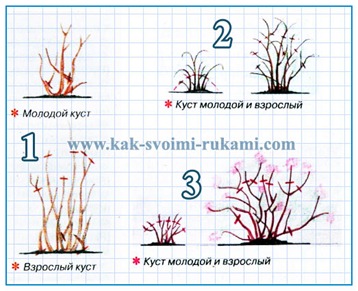 Pruning of adult bushes of this group can be limited by the removal of shrunken, diseased and damaged shoots. If there is an urgent need, you can cut or shorten live shoots.
Pruning of adult bushes of this group can be limited by the removal of shrunken, diseased and damaged shoots. If there is an urgent need, you can cut or shorten live shoots.
This is usually necessary to maintain the overall symmetry of the crown or the decorative appearance of the bush. However, most gardeners believe that there is always a need for pruning even this group of plants. They do not give replacement shoots, but over time they thicken the crown excessively, in addition, its shape is lost.
Second trim group
Plants are pruned in the summer immediately after flowering. Shrubs of this group form replacement shoots. They bloom on last year's growth.
These include: large-leaved hydrangea (Hydrangea macrophylla), weigela (Weigela), except for the species with variegated leaves, kerria (Kerria), tamarix (Tamarix), stephanandra (Stephanandra), kolkwitzia (Kolkwitzia), mock orange (Philadelphus), forsythia (Forsyth ia), Japanese quince(Chae-nomeles japonica), three-lobed almonds (Prunus triloba), early-flowering spireas (Spiraea): Vangutta, Thunberg, sharp-toothed, nippon, crenate, ashen, oak-leaved.
Shrubs of this group bloom, as a rule, in spring or at the very beginning of summer.
They shorten the shoots on which there were flowers. You can cut the %, leaving only the most strongly developing gain. At the same time, weak and thin twigs. About a third of the old shoots need to be cut regularly and to the base - they are usually already unproductive.
On a note:
Old shoots are darker in color than the rest. Also, they tend to be thicker.
Third cropping group
Prune plants in early spring. Shrubs of this group bloom on the shoots of the current year.
These include: summer-flowering spireas (Bumalda, Japanese, Douglas, loose-leaved, white-flowered, Billyar), David's buddley, paniculate and tree hydrangeas.
Mature shrubs of this group are pruned quite heavily in early spring. They begin to build up strong shoots, on which a large number of flowers will appear in the summer, or abundant flowering will come closer to autumn.
If such pruning is not done, the plants will begin to thicken and partially lose their decorative effect, and many will look unkempt. Without a given procedure, the quality of flowering of adult bushes may suffer.
When pruning, they usually try to remove all last year's shoots to the most well-developed buds located above the old part of the stem (at a height of about 5-7 cm from the ground). After a couple of years, the main lignified branches can become very dense. And if this happens, you need to thin them out to maintain the decorativeness of the bush.
Fourth trim group
Prune plants in early spring and after flowering. This group includes evergreen shrubs that need little pruning.
For example: rhododendrons, mahonia, boxwood.
After winter, dried and broken shoots are cut out from them. It happens that after an unsuccessful wintering, the shoots of mahonia are exposed - do not rush to cut them off (especially since they will bloom soon), wait until the buds wake up. In summer, faded flowers and inflorescences are removed from rhododendrons, and samsulas are cut off only if figures or borders are formed from them.
Haircut in the fall is also needed
Shrubs that form flower buds on growths of the current year bloom from mid-summer to autumn. You can cut them in the fall, while removing the entire upper part of last year's growths at a distance of 10-40 cm from the ground. After that, strong young shoots grow on the bushes, which will bloom. Such pruning can be done annually, or it can be done from time to time, as the crown thickens, the shoots become shallower and the plant loses its decorative effect. If wilted inflorescences look ugly, it is better to cut them off after flowering.
It is important to remember that heavily pruned plants must receive enough nutrition and moisture so that they can painlessly restore their above-ground part. It is useful to mulch the soil around them with compost. So you can cut summer-flowering spireas, Sargent's hydrangea, David's buddley, two-colored lespedets, rowanberry, etc.
We keep in shape
It is very important to preserve the previously set parameters of the shrub crown, its certain shape, typical for this species or created artificially, and also to maintain necessary for the plant illumination of all parts of the crown.
In connection with the local effect of pruning, they try to do it either on a side branch, the growth of which needs to be strengthened, or on a kidney, if growth is to be obtained in this place.
Such pruning is needed annually: both in spring and autumn. To maintain the shape, plants that have already been formed are usually cut off, because the bush grows and loses its decorative effect.
Usually, at the same time, parts of the growth are removed (cut off part of the shoot) of the previous year (spring pruning) or the current one (when pruning in autumn). It is easy to distinguish: the growth of last year, as a rule, is lighter than the long-term shoot.
Fast growing shrubs often require both spring and autumn pruning. For example, the broom (and other representatives of the Drokovs) grows quite strongly in width, as a result of which the bush literally falls apart, exposing the base. And if maintenance pruning is not carried out for several years, young shoots will grow, descending from old branches that have had time to coarsen by this time. This will drastically reduce the decorativeness of the shrub. When pruning like this, do not leave old rough wood, try to cut dead branches as low as possible. It is more correct to cut so that a younger growth is a continuation of the old shoot. The shortening of the current year's shoots will also stimulate the formation of new growths.
If you need to remove a branch, cut it close to the base of the current year's growth (next to the new shoot).
Anti-aging pruning
Boost the bloom with pruning!
In order for the flowering to be more abundant, and on shrubs that are not only decorative, but also useful (irga, viburnum, barberry, chokeberry), more fruits ripen, pruning stimulates the growth of new branches on already quite old specimens.
This type of pruning is more often used if the growth of the plant becomes too small and does not exceed 7 cm.
Such pruning consists in shortening the branches, which activates the growth of dormant or adnexal buds. It is usually held from February to April and from August to September.
It is important to know about the small distinctive features of shrubs that bloom on the shoots of the current year (Japanese spirea, tree and panicle hydrangeas) and the past (large-leaved hydrangea, lilac, forsythia, three-lobed luizeania, spring spirea, viburnum, hawthorn, honeysuckle honeysuckle).
There are also plants that bloom in the spring on the shoots of last year, and in the summer on the shoots of the current year: for example, weigela, kerria. In older bushes of this type, pruning will stimulate the growth of a fairly large number of side branches, which will make flowering more lush next season.
Shoots should be shortened by 1/3 from the top, cut off to well-developed buds (above them) immediately after flowering. In addition, branches that grow a lot of lateral growth every year will bloom more profusely and produce more fruit if one of the three oldest in the bush is cut. Do this in the spring about once every two years. This technique also avoids excessive thickening of plants.
Some features of anti-aging pruning
By pruning, you can also adjust the size of the flowers - a strong one leads to a small number of them, but they will be large. And after a weak pruning, many small flowers will appear. Some shrubs, for example, mock orange or action, with annual pruning, significantly lose the decorative effect of the crown. Therefore, it is better not to shorten all their shoots, but selectively.
Pruned to about three or four buds, from which strong young replacement shoots are then formed for flowering next year. The rest of the branches are left untouched. Only when the shrinkage of flowers becomes noticeable (usually this happens after a few years), you need to cut off all the shoots on the bush.
Plants can be rejuvenated
Shrubs age over time. However, different types it happens at different speeds. For example, in the willow-leaved spirea, colored lilac, rowan-leaved fieldfare, Dahurian and wrinkled rosehips, the stems live for six years. The longevity of the shoots of the vesicle is measured by seven to eight years. Potentilla shrub and medium and crenate spirea have different stems with different life spans, which range from six to fourteen years.
With anti-aging pruning, half of the old branches are removed annually in the spring. Hard pruning is also allowed, when the bush is cut off completely. So you can do with viburnum. At the same time, it should be taken into account that the species that give root growth, can be cut to the base (for example, viburnum or irgu). But the species that sprout from the lower part of the branches should not be cut to the base, but leaving parts of the stems 15-20 cm high above the ground.
The problem may be with shrub maples - it can be impossible to rejuvenate them, since they do not give growth at all, but the crown needs to be shaped.
When to do anti-aging pruning
It is better to carry out rejuvenating pruning in most shrubs in early spring. The signal to it is the shrinking of the shoots or they form weak ones.
It is necessary to cut off over the branches located closer to the base of the shoot, or in the place where the growth of the rejuvenated branch was most powerful.
Sometimes spend and weak rejuvenation. In this case, the size of the removed part of the shoot is not much different from pinching, and the effect of such pruning is usually low.
Radical rejuvenation
It is necessary when not only strong growths, but also weak short branches can no longer form on the bush.
All shoots are cut off at ground level in early spring. And if the shrub is formed on a rootstock (grafted plants), they are cut at a height of 10-15 cm from the place of vaccination. As a result, renewal buds will give new growth. And since the volume of the root system has remained the same, there will be quite a lot of shoots.
Then you need to choose the strongest and most well-located of them, and delete the rest.
By the way, you should not hurry with this: it is better to divide the work into two or even three stages, cutting out about a third of the shoots in one year.
In this case, in one copy there will be branches of two or three different ages.
How to cut
It is important not to rush to “demolish the heads”, but first carefully examine the bush. When working, try to shorten each shoot to a strong kidney. The cut must be made at a slight angle and at the very “eye”. This is necessary so that a stump does not form. It is important to strive to ensure that the cut surface is perfectly flat. Bark burrs indicate sloppy work and the wrong tool. If you are going to remove lateral shoots that extend from the skeletal branches, for example, growing deep into the bush (thickening), cut strictly along the annular influx located at the base of the shoot, and also without leaving stumps. The fact is that these stumps will dry out at best, and at worst they can begin to rot. And this is " opened door» for various infections.
Let us remind you once again: cuts of all branches with a diameter of 2 cm or more must be treated with garden pitch.
Pruning shrubs with beautiful leaves
This group includes species and forms of ornamental shrubs with original foliage: for example, the white-edged form of white svidina, golden forms of black elderberry and Bumapda spirea, red-leaved forms of hazel, barberry, skumpia, vesicle, variegated forms. They need to be pruned annually in early spring, and quite strongly. This is also done in order to cause the active growth of young shoots and their leaves have reached the maximum decorative effect.
Snowberry (Symphoricarpos), cotoneaster (Cotoneaster) and barberry (Berberis) do not require special pruning, although they tolerate shearing well and are often used in hedges.
With a free planting, these shrubs (all shoots) are usually shortened to 15-20 cm. In the future, the bushes are thinned out as necessary, cutting out the thickening and oldest branches completely or only their tops to a strong lateral branch. Of the coppice shoots, only those that will go to replace the old stems are left. Sanitary and anti-aging pruning is done in the same way as with most other shrubs. Semi-shrubs, for example, ornamental raspberries - hawthorn (Rubus crataegifolius), beautiful (R. deliciosus), fragrant (R. odoratus) - are pruned in the same way as their fruit relatives - obsolete biennial branches are annually removed.
Plants on a stem or Stem bushes
In ornamental horticulture, depending on the size of the trunk (the distance from the root collar to the first branch), there are bole (height - up to 0.25 m), semi-bolt (0.25-0.75 m), bole (0.75-1 .2 m), low stem (i.2-i.5m) and high (more than 1.5 m).
The stem is inherent in trees, to a lesser extent in shrubs. But it is the cultivation of shrubs on the stem that emphasizes all their beauty and originality. Usually such artificial forms are planted on the lawn singly (tapeworms).
By the way!
You can enhance the growth of shrubs on low trunks. To do this, choose a powerful shoot in the crown, growing from an upward bud, lift and fix it on a support. Then, with a pinch, they begin to form a second "umbrella". And the first pinching is done in the spring at the right height, the emerging side shoots are cut as needed.
It is quite common to grow weeping forms of plants on the trunk. This can be found in deciduous shrubs: amorpha, euonymus, privet, hawthorn, elderberry, deren, willow, caragana (yellow acacia), hazel, holly, broom, robinia, boxwood, skumpia, forsythia, genome-forest. Sometimes plants are grown on boles that give shoots, or are undersized. Look great in this form chokeberry ( chokeberry), grafted on mountain ash; creeping euonymus - in B. European; almonds (three-lobed, louiseania) - on cherry plum, plum, almond or bird cherry; ivy - on aralia; lilac - on privet or ash; chaenomeles - on a pear, mountain ash or quince.
Often they are grafted onto a trunk to show the beauty and grace of individual flowers of a plant, for example, standard roses. But for their good flowering, proper pruning is important.
Supportive pruning of the rose "tree"
In the first year after grafting in the spring, having removed the shelter, the stock is cut 1 cm above the bud. The cut is cleaned and smeared. When the escape varietal rose will grow to the fifth leaf, the top needs to be pinched.
After that, side branches will begin to grow. They are also pinched after the third or fifth leaf, until a beautiful crown is formed.
By the way!
Getting vaccinated standard rose you can speed it up a bit. To do this, on the highest young shoots of wild rose (without digging it up), it is necessary to vaccinate in the spring. And in the fall, the plant is dug up and planted separately for growing.
The standard rose must be tied to a support, but do this not near the graft, but slightly lower so that it does not get damaged. By the way, two supports are often installed - one against the other.
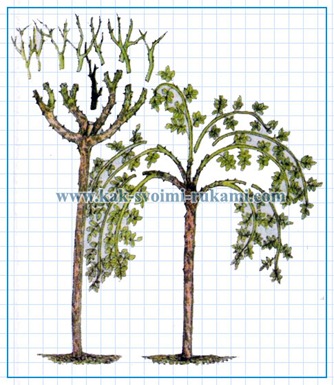
It is important throughout the season to remove the shoots both on the stem and extending from the ground (from the roots), as well as to pluck the emerging buds. Then all the food will be spent on the formation of a beautiful crown with strong shoots.
In the second and subsequent years, the plant can fully bloom. And the buds are removed only on diseased and weak specimens.
And after the first flowering, the plant can be pruned. At the same time, the shoots are shortened to the first strong buds that have started to grow. At the same time, not cut out from the middle of the crown flowering shoots and branches growing inside the crown.
By autumn, faded flowers are no longer removed on the rose, since after that the seed setting begins, which inhibits the awakening of new buds.
At this time, it is important for the rose to prepare for the winter, and not to build up new shoots, as happens if wilted flowers are cut off.
Pruning tea rose and floribunda rose
They are pruned immediately after removing the shelter (around March), when the buds are still sleeping or they have already pecked slightly.
In the first year, all strong shoots need to be shortened by 5-6 buds - they will be 15-20 cm long. At the end of the season (approximately in November), all flowering shoots are shortened and non-flowering ones are cut off, as well as those that have not had time to lignify by winter. In the second year in April, all dry, diseased, weak and thickening shoots are removed. The young growth is shortened by five to six buds, and the remaining lateral branches are cut to 10-15 cm (about three to four buds remain on the stumps). hybrid tea roses usually given the shape of a bouquet, and floribunda groups are more often cut into a hemisphere.
Good climbing roses!
To get a spherical or weeping rose crown shape on a trunk, climbing or ground cover species are used for grafting, giving many young branches per season.
They are formed like shrubs from the first pruning group. They bloom in June-July on lateral shoots that appear on last year's stems. If the crown is thick enough, in September all last year's shoots are cut off, leaving the growth of the current year. If there are few branches, two or three biennial stems are left, cutting them into two or three buds.
Standard roses can be cut more compactly so that the crown looks like an oval or a ball. This is often done with large-flowered varieties. If you plant such a plant, the beauty of your garden or its area is guaranteed!
Types and rules for pruning standard roses
Cut off in the spring for three to six buds (leave a shoot 10-15 cm long). Cutting shorter is dangerous, as very powerful shoots are formed that distort the crown. Usually hybrid tea, polyanthus, miniature and floribunda roses are cut this way. These are roses that bloom on the shoots of the current year.
Only 10-15 cm shorten the ends of the shoots. This is done with park and climbing groups of roses, because they bloom on the shoots of last year. On the eve, all broken and damaged shoots, as well as dried and thickened ones, are removed. In the crown, three to six of the strongest and youngest are left, preferably unbranched and diverging in different directions.
If after winter the stem of the rose comes out very frozen, cut it very short. Moreover, if the vaccination site was not affected, it’s not scary: the plant will soon recover, giving new shoots.
On a note
- A wet wrap with sphagnum moss will help the kidneys wake up faster. They are surrounded by places where the kidneys should wake up (usually at the base of the shoots), and fixed with lutrasil.
- Remember: in the crown, especially the old one, dead stumps should not accumulate. Every spring, you need to carefully cut everything and cover it with garden pitch.
- For the formation of the crown of a rose, it is very important in which direction the bud is directed, on which the cut is made. Usually, the upward direction grows more actively - it is more often preferred to leave it at the cut. But if a variety with a very spreading crown and sparse shoots is grafted onto a stem, they are cut to a bud directed inside the crown.
Man-made "clouds"over flower beds
The standard form, which is given to plants for several years with the help of a haircut, can be considered one of the most striking methods of decorating a garden.
And every year there are more and more admirers of plants on the stem - garden owners are pleased to create something perfect with their own hands. And this is understandable, because the slender crowns of various shapes above the flower beds are fascinating.
The elegance and solemnity brought to the garden by standard plants make it orderly and cozy.
These plants do not take up much space, and they can easily be "fitted" into the landscape of the small garden. And it is not difficult to grow and form such plants, it is only important to master some knowledge.
Such plants in ceramic tubs are very beautiful. And in this case, the range of cultivated plants is expanding due to heat-loving ones.
For the winter garden species on the stem, it is imperative to insulate both the crown and the root system or store them in an unheated room. And heat-loving bring into the house.
Fruit bushes on trunk
Standard plants literally burst into our gardens. Many gardeners give them preference, trying to create a miracle on their site. And more and more often, among ornamental shrubs or right on the lawn, fruit bushes are grown, which are beautiful in bloom and, moreover, delight with delicious berries. They fit very well into the landscape of the garden, harmonize with flower beds, because they are grown on a trunk.
Creating a standard plant, despite the apparent complexity of its appearance, is quite simple. And the most affordable option- to grow own root trunk. To do this, in July, a stalk with five or six "eyes" is cut out from the middle part of the shoots of golden or red currant and planted in open ground. And they do it so that only the apical bud remains at the soil level. For the winter, it should be covered with dry leaves so that the stalk does not suffer from frost, which can happen when the soil is not yet covered with snow. In the spring of the next year after planting, the apical bud will start to grow. Your task is to grow one shoot, so in the process of its growth it will be necessary to remove all lateral processes.
Usually, by the end of summer, the height of the shoot reaches 80-100 cm. And in order for it to be strong and healthy, it is important to water the plant and be sure to feed it. For top dressing in early summer use nitrogen fertilizers, and at the end - a mixture of phosphorus and potassium (according to instructions).
In the spring of next year, the grown shoot is cut off at a height of about 75-80 cm from the ground, leaving only three or four upper buds for further growth. All the rest must be removed to the very base of the escape. Over the summer, three or four shoots are formed from the abandoned buds, which will have time to grow up to 35-45 cm, sometimes a little more.
The next year, all shoots must be shortened, leaving also three or four buds on each of them at the base. Thus, in three seasons it is possible to form a full-fledged standard plant, which will begin to bear fruit in the third year.
Gooseberry "tree"
It will take a little more time to form a gooseberry stem. When choosing varieties for this, it is better to give preference to large-fruited forms that are resistant to powdery mildew: for example, Date or Warsaw - with strong shoots growing straight.
If such a variety is already growing in the garden, in the spring you need to dig a branch of the uterine bush, and in the fall the resulting layering should be separated and transplanted to a permanent place.
Then you need to repeat all the steps that you did with golden or red currants.
The height of the trunk is usually 60-100 centimeters.
The crown of such bushes is usually formed by a ball or a hemisphere.
By the way!
If you make a currant or gooseberry bole very low, up to 15 cm, you get a so-called improved bush. He has all the trunks come out almost from one "point".
Such a plant is more graceful than a natural bush with a wide base, in which the stems grow directly from the ground at some distance from each other. They take care of the bush on the "leg", like a standard form, of which, in essence, it is a modification.
Other ways to get a stem
You can get a standard plant not only from an annual seedling grown from a single-bud cutting. Ordinary seedlings are also used. Choose the strongest and smoothest shoot. All buds in the root zone are removed from him and lateral shoots that have managed to form by this time at a height of about 40-50 cm.
The rest of the kidneys are given the opportunity to develop, and from them they subsequently form the crown of the bush.
A good trunk can be grown if an opaque tube (not too dense) is put on the shoot of the seedling. Its size should be equal to the height of the future trunk. It is important to deepen its lower part into the soil. But such a tube should not replace the support. It is necessary to install supports for any method of formation.
Rules for pruning standard fruit bushes
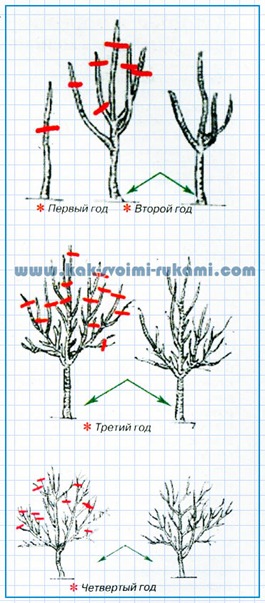 Do not allow strong growth of the crown standard plant: excessively large will look unsightly, and the trunk can break. An overgrown crown does not need to be afraid to cut.
Do not allow strong growth of the crown standard plant: excessively large will look unsightly, and the trunk can break. An overgrown crown does not need to be afraid to cut.
Do not be afraid to remove flowers - pruning will stimulate branching in any case, and new flower stalks will definitely be laid over time.
Be sure to remove the lateral shoots that appear just below the crown (on the trunk). Otherwise, increasing in size, they will take a lot nutrients to the detriment of the development of the main beautiful part of the plant, and the decorative effect will suffer.
Periodically cut off the young shoots that appear on the trunk in the summer at its base. Sometimes shoots, and in fairly large quantities, may also appear from the ground.
If the plant still has a weak bole, you need to give it the opportunity to finally form - tie it to a support. The main thing at the same time is to make the loop free, otherwise it can damage the trunk, which is still very tender at a young age.
You can renew such a plant by cardinal pruning (by two or three buds) of all shoots in early spring before the bush awakens.
Shearing topiary plants
Pink "balls" willow Hakuro Nishiki
Whole-leaved willow Hakuro Nishiki (Salix integra Hakuro Nishiki) is a very plastic plant. And if properly formed, it can grow not only as a bush, but also as a tree, and in this case you can do without vaccination .. Such plants look especially interesting if you plant them with a tapeworm.
I advise you to do this already at the end of this spring, since such a formation will take more than one year.
First you need to root the willow stalk. Fortunately, its shoots take root easily. They are planted in moist soil, covered with coarse sand from above with a layer of 2-3 cm (the place should be shaded), covered with a jar.
In the first year, the apical cutting is allowed to grow freely, if it is taken from the middle, the strongest and most even of the shoots is left on it (in the future it will be a stem) and it is also allowed to grow freely. In the next year or two, you need to remove all side shoots to form a bole. And only then, at the chosen height, pinch their top. From this moment, the formation of the crown begins. The lateral shoots that appear at the top need to be pinched two or three times per season so that the “cap” becomes thicker.
In an adult plant in the spring, in the middle of the crown, old shoots are cut out, last year's ones are shortened, and do not forget
get rid of thickening small twigs. In the summer (no later than July), young growth is shortened.
With such a haircut, the plant will always look neat and show off in a pink “outfit” twice a year.
Willow Hakuro Nishiki, formed into three stems, looks even more attractive, especially when viewed from different points of the garden.
Curly pruning of shrubs
Curly cutting shrubs is not just a way to diversify and decorate the landscape of the garden. It turns out that the skill of creating topiary, both simple and complex, is one of the most ancient arts.
In fact, from any shrub, using special techniques, you can create a figurine of an animal, some kind of fairy-tale character, a sphere or other geometric figure, a cup or plate, embody an architectural masterpiece in greenery, or even cut out a whole picture.
It is generally accepted that topiary plants are an attribute of regular and architectural gardens with strict lines, geometrically consistent and restrained colors, often shades of green. However, topiary art is not only suitable for English gardens. Such figures will successfully fit into any garden with any design, the main thing is to choose the right style, shape, as well as the way they are executed.
A simple haircut
To form a topiary, you need to choose only the strongest, healthiest shrub with a dense crown and uniform branching.
At the first stage of such a haircut, the plant is given only an approximate outline. future form. For this large garden shears cut the main contours, outlining only the main lines and removing all unnecessary. Only then do they proceed to a more thorough trimming of the crown, remove all the small branches that have broken out of the main lines.
At the second stage, you need to arm yourself with smaller garden shears, which are more often used for curly haircuts. After achieving a shape similar to the end result, the plant is allowed to gain vegetative mass, which will take about a year. During this time, young shoots will slowly fill the voids that have formed and create the necessary Foundation for the final formation of the figure.
Then, in the middle of summer, the haircut is repeated using small garden shears.
After in August, it remains only to make the final adjustment in order to get perfectly even edges and walls of the figure.
This pruning is reminiscent of polishing an almost finished product.
More complex figures
They are more difficult to form. In this work, you will need a wire frame. It will help to set the growth contours and facilitate the cutting process itself, since it will be a guideline and with its help you can outline the lines. A wire frame is installed on young plants, the dimensions of which more closely match the parameters of the workpiece.
At the first stage, the main lines are formed, for which all the outlines of the bush are adjusted along the contours of the wire frame. For these purposes, they do not always use pruning, sometimes they simply direct individual branches, tying them in the direction necessary to form the figure. Usually, only those tops that are strongly knocked out of the shape you need are sheared. More specific pruning is carried out as the plant grows - then all its outlines are again adjusted using small garden shears.
Complex figures usually have to be adjusted several times a season as new branches grow and break out of the contours of the green sculpture.
Yew, BOXWOOD, HOLLY…
Most often, green sculptures are created on the basis of small-leaved, as well as densely branched plants that tolerate shearing without problems: boxwood, yew, holly, arborvitae bush form, privet, barberry.
Forming - step by step process creating the desired figure. And it will require not only special skills, but also patience, endurance and attentiveness.
Shrub plants can be given virtually any desired shape, however, for beginners in this matter, it is better to start with the simplest geometric shapes - a pyramid, cylinder, cube or sphere. Only after mastering the basic techniques of cutting and bringing the skills to perfection, you can begin to create more complex forms.
When cutting, use only clean and sharp tools.
Before working around the plant, it is advisable to lay out a film or burlap, which can then be easily collected and discarded along with the scraps.
Hedges
Building hedges
Cutting a hedge is needed not only to get the desired shape, but also to increase the growth of side shoots, which makes the hedge thicker.
You need to start cutting in the first year after planting. shrubs autumn planting pruned in the spring, and if planted in the spring, their shoots should be shortened in early spring the next year.
If poorly formed seedlings with an open root system are planted on the site, their shoots should be cut in half. And those that were formed back in the nursery (with a closed root system) are shortened by about a third.
blooming fence
Quite often, a real masterpiece is created in the garden - a blooming hedge. Almost all shrubs are suitable for her, which can be combined to your liking. But more often, fast-growing and competitive plants are used - yellow acacia, weigela, hydrangea, deutsia, viburnum buldenezh and pride, lilac, shrub cinquefoil, blood-red and golden currants, as well as forsythia, mock orange, spirea and winged euonymus.
hedge from blooming in summer bushes, for example, David's buddleys, must be pruned strongly, and every spring, - and it will give abundant flowering, and the flowers will be larger than usual.
Shrubs that bloom in spring should be thinned out about once every 3-4 years immediately after flowering so that the intensity of flower formation does not decrease.
If a flowering hedge is very bare, in spring or autumn it is cut radically (up to old wood) - then such shrubs will respond with the formation of new shoots. At the same time, the strongest of the young shoots are left and shortened in the spring of next year, which will enhance their branching. Correction and width of the "wall" is also allowed. For this purpose, all branches that strongly protrude beyond the perimeter of the previously formed shape must be cut at the base.
When to cut?
A hedge of deciduous plants is cut for the first time in the second year after planting, and then annually. Young bushes should be pruned once a year. In the next 3-4 years in June-July, the annual growth is shortened by a third or even by half. Since this stimulates the formation of new shoots, the crown is formed without holes and holes.
Mature shrubs are sheared two to three times a year, usually in spring, then in mid-summer and autumn. It is important to remember that every year the height of the haircut must be increased by 5-6 cm until the hedge reaches the required size.
Fast growing plants need multiple shearings during the season (from May to October inclusive).
Less often, about twice a year (in the middle of summer and autumn), slow-growing species are sheared: for example, barberry, common cotoneaster, snowberry.
· Sea-buckthorn, white and blood-red turf, sucker, common and Amur barberry, vesicle, irga, common hazel, Hungarian and common lilac, mock orange, viburnum proud.
· For the formation of a hedge with a height of 1.2-2 m, a dog rose, a Russian broom, a brilliant cotoneaster, spirea, a shrub caragana are suitable. barberry, snowberry, etc. *
You can divide the garden into zones with the help of bosquets (smooth “walls” that form an “office” in the garden) 1-1.2 m high. For their formation, you should use almonds, cinquefoil, undersized barberries, spireas and mock oranges.
Features of cutting hedges and "walls"
The depth of cutting should not be immediately large, it is increased as the growth and age of the plants in the hedge increase.
In young plants, usually a third of the annual growth is cut off in June-July, but with age, when the natural growth of shoots slowly fades and needs to be stimulated, you can shorten them by half. Such pruning will not only improve branching, but also the formation of more large leaves, which is very important for old plants.
As the hedge reaches the required height, the haircut can be carried out more deeply, up to leaving only small stumps 2-3 cm high from annual growths.
All vertically directed shoots must be cut until the lateral branches that form after shortening them reach the desired height. In the future, it remains only to periodically adjust the general appearance.
As soon as the hedge reaches a predetermined height, it is necessary to carry out a constant apical haircut - to maintain shape. This is a mandatory technique, since even a small regrowth of shoots can greatly spoil the shape of both a rectangular and a trapezoid hedge. You can cut less often if the triangular hedge and unevenly growing shoots are not so noticeable.
Important!
In the climate of the middle lane, the best form of hedge is conical or trapezoidal (when viewed in profile). If the bottom is wider and the top is narrower, the hedge is better illuminated by the sun, which means that the bottom of the hedge is not exposed, and the plants are bushing more actively.
Possible hedge problems
Shearing the "walls" of deciduous plants does not end only with pruning the tops of the shoots. If you do only this, after a few years the shrubs will loosen, the shoots will sag, the hedge will lose its former decorative effect.
The “wall” needs to be cut more deeply from the sides, so that, if you look in profile, the height is much higher than the width, and does not approach a banal square from year to year.
Remember: the wrong haircut will lead to poor lighting conditions, the bottom of the hedge will be exposed, many dry branches will appear, and the density of each plant will decrease.
I strongly recommend shortening the shoots of a neglected hedge to half the height and width. In some cases, cutting “on a stump” is even allowed (pictured), after which you will have to form everything all over again.
How to upgrade plants
A rejuvenating haircut is usually needed not only for neglected hedges, but also for those that have lost their decorative and protective (this applies to plants with thorns, for example, hawthorn or wild rose) properties. Such a haircut should be done in the spring and preferably in two stages: in the first year, cut one side, shortening the branches at a distance of 10-12 cm from the trunks, and cut the second, as usual. The next year, repeat the same operation on the other side.
If it is required to rejuvenate the hedge as quickly as possible, in one season they trim both sides at once.
Some rules for trimming a hedge
Try to make the cut oblique and over the most well-developed healthy bud, directed towards the periphery of the bush. This is especially important when forming a young hedge.
Shearing hedges from evergreen (not coniferous) plants is in many ways similar to the formation of "walls" from flowering shrubs. The first time they are sheared in the spring and not earlier than a year after planting or transplanting. At one time, you need to cut off no more than a third of the green mass. If you want to make the crown thicker, at the end of the season, shorten the shoots that have grown this year, repeating the previously formed crown shape. After shearing, never leave bare segments of branches that do not have buds or leaves at the top - they are likely to dry out.
After pruning, all plants (flowering, deciduous, evergreen) need to create conditions for quick recovery: water abundantly, fertilize, and also mulch the soil.
For cutting green hedges, it is better to use a manual pruner or scissors. They cause less damage to plants and allow you to more beautifully form a hedge. The only negative is that it takes more time to work. It is much faster to perform it with an electric tool. However, immediately after the haircut, you can see how the leaves are soaked and cuts are made in not quite the right places. However, all edges are smooth.
Beginners can be advised to cut on stretched cords or wire frames. It is desirable to paint landmarks in some bright, noticeable color. Then it will be easier to work.
With regular trimmings of the hedge that maintain the shape, each subsequent cut should always be made at least a little, but higher than the previous one. If each time you cut the shoots at the same level, the hedge may be too bare. She will not have a "green frame" of repeatedly branching young branches covered with foliage.
Stephanandra tender shoots
Stephanandra has a medium crown size. It blooms in summer, but the flowers are inconspicuous, so the plant is valued for its decorative autumn coloring leaves, as well as for bright shoots that effectively decorate the garden in winter. Suitable for hedges, as it actively builds up shoots. AT middle lane it is desirable to form a low curb that can winter under the snow. In general, stephanander does not differ in good winter hardiness and in cooler regions it can freeze to the level of snow. But do not be afraid: the plant usually quickly restores the above-ground mass (in 40-50 days). However, it is both possible and necessary to speed up the regeneration process. After waiting a while to make sure that the buds do not bloom, it is necessary to cut all the shoots to green, live buds, and process the cut points. If you plant stephanandra among shrubs, you can not think about pruning in the first few years.
Starting from about the fourth year of life in the garden, the crown of the bush must be thinned out, for which every fourth adult stem is removed in the spring.
In summer, it is desirable to prune all faded shoots, cutting them to the strongest side branches, trying to keep as natural as possible, that is, the spreading shape of the crown of the bush.
Older plants, which are eight or more years old, form a mass of thin interlacing and short shoots, strongly thickening the crown. There is only one way out - to cut off all the shoots to the ground, rejuvenating the bush. Such pruning can be carried out both in winter and in early spring a week or two before bud break. And the next year, around the middle of summer, when the young shoots grow up, pinch their tips.
Diervilla
It is desirable for this plant to release more space, as it forms many root offspring. And as a result - lush curtains, which, by the way, turn red in autumn.
In limited conditions, it will be necessary to restrain the growth of diervilla honeysuckle, cutting the bush along the perimeter in the spring, and at the same time making sanitary pruning. If the soil is nutritious, the growth of new shoots will be too active, so you need to cut the extra ones in the summer.
Pruning subshrubs
Shearing is needed for semi-shrubs
Most semi-shrubs also need to be trimmed regularly to avoid thickening their crowns and losing their decorative effect.
A few days before the plants completely fade, remove all flower stalks and shorten the leafy parts of the bushes by about 5-6 cm. This procedure sometimes prolongs flowering or stimulates re-blooming. If the semi-shrubs do not grow in a group, but separately, when pruning, it is better to give their crowns a semicircular shape - this way they will look more attractive, especially before and after flowering.
If you decide to prune in the spring, it is better to do it more drastically and preferably before the growth of young shoots begins. At the same time, last year's stems are shortened at a height of 15-17 cm.
Significant pruning, as a rule, is subjected to lavender, santolina, medicinal sage, hyssop, lofant, etc. Their pruning is aimed at maintaining the compact shape of the bushes. By the way, in suitable conditions(soil composition, moisture) these semi-shrubs winter well in the middle lane.
If you tighten the pruning of lavender and sage, the regrown young shoots will not have time to mature before the first autumn frosts and may partially suffer, or even freeze completely.
More radical pruning is also necessary for semi-shrubs of the late flowering period, for example, alpine aster. It is cut quite low above the ground, after which the soil is mulched with compost, which will insulate and be top dressing next season.
pruning hydrangeas
Before cutting, you need to know exactly what kind of hydrangea (Hydrangea) you have - paniculate, tree-like or large-leaved. Each has its own characteristics.
By the way!
Pruning is possible because plants have the ability to regenerate lost parts. Even if it is made where there is neither a side branch nor a visible bud, shoots appear from sleeping buds. However, remember that as you approach the base of the branch, the effect of pruning gradually fades.
Panicled hydrangea (N. panicuiata)
Pruning a paniculate hydrangea will not be difficult if you remember that it blooms on the shoots of the current season.
You can prune in autumn, winter or spring. There is no need to do this annually.
Cannot be cut in summer: flower buds have already formed at the ends of new shoots, and the hydrangea is preparing to bloom. I like to do it in early spring. I remove small, weak, rubbing and intersecting branches. I shorten the strong ones, following the same principle as in the case of the tree-like one: if there are many annual shoots, each individual inflorescence will turn out to be smaller.
Panicled hydrangea on a bole
From the paniculate hydrangea, you can form a standard form. To do this, all the shoots are cut out from a young bush in the spring, leaving the most powerful one. It is driven out up to 70-100 cm, regularly removing all side shoots and shoots. The crown is usually formed spherically. Such a “tree” is very impressive, but you need to remember: panicled hydrangea shoots are very brittle, and the inflorescences form a huge “cap” and can break off without additional support.
In general, the fragility of shoots threatens not only standard "trees", but also bushes, especially overgrown and uncircumcised. For the winter, I cut off the inflorescences of all hydrangeas, and tie the shoots. A weak solution of potassium permanganate will help to strengthen the strength of the shoots. Several times during the summer I water them hydrangeas.
Needs to be cut very carefully. garden hydrangeas. Heavy pruning often leads to poor flowering of the plant. And paniculate hydrangea, on the contrary, is cut to two to six buds. If you cut not so much, small inflorescences will form.
Pruning tree hydrangea
Tree hydrangea (H. arborescens), for example, the most common Annabelle variety, blooms on the shoots of the current year. This means that in autumn you can shorten all shoots at a height of 20-25 cm from the ground. And in early spring, cut off about a third of the old shoots at soil level.
Firstly, this is necessary so that the bush is not thickened, and secondly, as a result there will be somewhat fewer inflorescences, but each of them will form much larger. And thirdly, so that the bush was a beautiful spherical shape, and the inflorescences grew on strong stems and “looked” up. Otherwise, heavy "caps" will grow, hanging at the ends of long, arcuately curved "rods". The only period when you can not cut tree hydrangea- late spring. At this time, the plant is preparing to bloom.
We form a macrophylla. Work calendar
There are subtleties in pruning large-leaved hydrangea (N. macrophylla). Many experts do not consider it necessary to cut it at all, they only remove old, damaged and weakened branches, and at any time.
First year
After planting in autumn or early spring, the main growths are shortened by a strong bud (or two), weak ones are cut out and the root system is well mulched with humus.
October November.
At the base of the crown during the growing season, several strong growths were formed and big number side branches on the main shoots - only the weakest or breaking symmetry are cut.
Second year
June. Flowers are formed on last year's growths. After flowering, new strong shoots form from the base. July. After flowering, you need to cut off all generative shoots for new powerful growths that have grown below (shorten to them).
Third and subsequent years
July. Immediately after flowering, all faded shoots are removed to healthy growths located below, and all weak branches are cut out completely. If the bush becomes very thickened, a quarter of all old shoots are also cut out to the base. Elena POTAPOVA, Mytishchi, Moscow Region
In hydrangea, which blooms on last year's shoots, inflorescences with three or four nearest leaves are cut off at the end of July.
The fact is that in August she begins to lay flower buds of the next year, which ripen during August - October. If you cut such a hydrangea in late autumn or do it too radically, flowering in next year will not.
New method of pruning macrophylls: flowering is better!
Refurbishment large-leaved hydrangeas bloom not only from the apical buds of shoots (the first wave of flowering), but also on lateral perennial shoots, as well as annuals that appear below ground level. They bloom later. It is the property to repeatedly or repeatedly bloom that is called remontance.
A new method of pruning large-leaved remontant hydrangeas is aimed at making them bloom well in cold climates. Already in July, the branches of the bush without apical flower buds cut very short, leaving one lateral bud on each branch (as close to the ground as possible). Such kidneys can easily be covered for the winter and saved. This pruning stimulates the laying of a flower bud, which will have time to ripen by next spring and bloom. In addition, it stimulates the formation of flower buds on the roots, from which annual shoots appear in spring. They will catch up with perennials in growth and, most likely, will also bloom.
Next spring, this bush should be intensively fed every week until August with fertilizers with trace elements and high content nitrogen (good in this case, the ratio N:P:K - 3:1:1 has proven itself). For the winter, the plant falls asleep just above the cut branches.
By the way, in regions with a cold climate, this pruning method will also allow less frost-resistant non-repairable varieties of hydrangeas to bloom well.
Igor ARKATOV, collector, Kazan
Spirea pruning
Spring shaping
Spring flowering spireas: oak-leaved; arguta, or sharp-toothed; gray, or ashy; Thunberg; Wangutta; nipponian; plum-leaved.
In the first year after planting, it is only necessary to slightly shorten the skeletal shoots, remove all weak, damaged branches and those that grow inside the bush.
In the second year, immediately after flowering, you need to cut off all faded shoots to the strongest and youngest side shoot. All weak branches should also be removed, cutting them in such a way that the crown of the bush is symmetrical.
In the third and subsequent years (also after flowering), it is necessary to cut the faded branches to the strongest and youngest side shoot, cutting out the old ones (3 or more years). Thus, the procedure for rejuvenating the bush begins.
Summer shaping
Spirea summer term flowering (S. Japanese, Bumalda, birch-leaved, Willard, Douglas) are pruned in late June or early July after flowering.
Pruning young plants can be handled with pruning shears, adult spireas may have thick shoots and may require a garden saw.
You need to start cutting spireas of any flowering time from the first year of life. Usually, immediately after planting in the spring, all shoots are shortened by about half to a strong outer bud pointing outward. All weak shoots are completely cut out.
Then pruned in the summer immediately after flowering. And first of all, all faded inflorescences are removed, which stimulates the growth of lateral shoots, and this will allow flowering to continue as long as possible (especially in Japanese spirae).
In the second year in the spring (approximately in March or early April), all shoots are again cut to half the length. In summer, you can also limit yourself to pruning only faded inflorescences. For the third season, you should repeat the spring and summer pruning, while removing all old shoots that are more than three years old, cutting them to the ground.
We cut the lilac
Do not break, but shear
Prune lilac preferably annually or at least every other season. In the middle lane, this is done in the spring before the start of sap flow. Since the flower buds are on the tops of last year's shoots (usually the strongest, located in the upper part of the crown), they are not shortened, as in fruit trees. This is the basis for future flowering. Remove all weak, thin, twisted and growing shoots inside the crown that do not have full-fledged flower buds. Broken and dried cut out throughout the year. For the next season, the best ones are selected from young sprouts, and unnecessary ones are removed.
Immediately after flowering, faded panicles are cut out. This not only improves the appearance of the bush, but also relieves it of the need to expend energy on the formation of seeds.
In grafted plants, the formation of "wild" shoots is possible: it is removed throughout the season immediately as it appears, leaving no stumps.
Rejuvenate old lilac bushes
Rejuvenating pruning improves the appearance of lilacs and the quality of flowering, increases the resistance of plants to diseases and pests, and increases their lifespan. In addition, by replacing old trunks, you can slightly reduce the height of the bushes in order to bring the flowering zone closer to human eye level. For this purpose, in early spring, old trunks with peeling bark and small increments are cut down, leaving low stumps, or they are transferred to a good strong lateral branch. During the season, strong shoots grow on them, which form a new bush. It is better to rejuvenate very old specimens with weak shoot formation in stages, alternately removing the trunks for several years in a row. Own-rooted bushes can be cut below; the grafted rejuvenate more carefully, taking care not to accidentally cut off the entire graft.
Why did honeysuckle die?
Last year, I cut out all the old branches from the honeysuckle to the ground. The plant has died. Why?
Irina Churakova
If the honeysuckle bushes are cut almost to the ground, only a small number of dormant buds in the root collar zone can wake up, and even then, if there is no drought. When rejuvenating pruning of old honeysuckle bushes, hemp is left 30-40 cm high from the soil level. After this procedure, young shoots grow. At the same time, it should be taken into account that too many of them can grow, so in the third year the updated bush should be thinned out. Depending on the variety, you can leave 10-15 of the strongest and evenly spaced branches, and remove the rest.
Forsythia pruning
This shrub is a bright representative of the Olive family, and even before the first leaves appear, it pleases with a magnificent fountain of golden flowers. Quite often, for-position is also used to form a flowering hedge. After flowering, the bush is an excellent background for other plants.
Unfortunately, forsythia quickly thickens, losing its decorative effect, so periodic pruning is needed. Only it is impossible to shorten the bush much, otherwise it will bloom weakly. Strong pruning is only necessary if the plant is not branching well.
In the first two or three years after planting, the shoots of the seedling need only be slightly shortened. After the first winter and every spring, sanitary pruning is done. There is no need to be afraid: it will not harm the plant, on the contrary, it stimulates the growth of shoots and gives the crown density. Since the forsythia is growing rapidly, some of the shoots are ugly out of the outline of the crown. They can be cut or, better, pinched in time throughout the season. Starting from 3-4 years of the life of the bush (when it grows up and gets stronger), you need to start more serious pruning, while not forgetting to carry out a sanitary one every year.
It is better to prune the forsythia after it has completely bloomed (in the middle lane this is around June). Shoots should be cut over a strong bud or a strong side shoot. Cut off all dry and old shoots up to 4-6 cm from the ground, which will stimulate the growth of new ones. Such pruning will help regulate the thickening, as well as the height of the bush. You can give the forsythia any shape you want. Single bushes are usually allowed to grow well. Once every three years, the crown must be adjusted. If this is not done, the bush can stretch out a lot, and it will bloom weakly and not as brightly as well-groomed specimens.
If forsythia grows in a hedge, it also needs to be cut about once every three seasons. And pruning will be, rather, not corrective, but rejuvenating. At the same time, the shoots are shortened by 2/3 of the length or cut off completely, that is, “on the stump”. And this will give impetus to active growth from the base of the new "hair" of the bush.
Every time we buy seedlings of new varieties of ornamental shrubs, we rejoice like children, imagining what a miracle will grow in our garden in some 2-3 years - almost the same as in a luxurious photograph from a colorful catalog. But time passes and it turns out interesting thing- it turns out that in order to see the longed-for miracle in your garden, you need to work hard to create the conditions for the "living" of the new settler and to form his appearance. Tips from our material will tell you how to prune ornamental shrubs so that the plants develop well.
When to prune ornamental shrubs
The procedure should be carried out before the appearance of the kidneys and the start of sap flow.
- In the southern regions where climatic conditions allow, formative pruning can begin at the end of February.
- In the Moscow region, pruning should be completed before the end of March.
- In the northern strip of Russia, it is recommended to wait until the beginning of April.
At temperatures below 10 ° C, pruning is not recommended: the tree crumbles and the wounds do not heal well.
Latest articles about gardening and gardening
Shrub pruning tools
For any type of pruning, you may need a pruning saw, a lopper, a two-blade pruner, a garden knife for annual growth, a hedge trimmer, a ladder, garden pitch, or rannet paste. All instruments must be sharp and sterile. A day after pruning, treat sections with a diameter greater than 7 mm with garden pitch or wound healing paste.

Types of pruning ornamental shrubs
All ornamental shrubs require timely and correct pruning aimed at removing dead and damaged shoots, at containing rapid growth and the formation of a beautiful crown (by cutting and thinning), to stimulate flowering, as well as to rejuvenate old bushes.
In relation to ornamental shrubs, pruning is of 3 types:
- sanitary;
- formative;
- rejuvenating.
Almost all shrubs need sanitary pruning. Most people need a formative one. There are only a small number of shrubs that do not need formative pruning. They have enough annual sanitary pruning every spring, in which all weak, frozen, crossing shoots are removed.

Pruning flowering ornamental shrubs
Beautifully flowering shrubs are grown for their magnificent flowers, so the main goal of pruning them is to achieve abundant flowering. Such shrubs are grown for their beautiful flowers, so the main purpose of pruning such shrubs is to achieve lush flowering. According to the features of pruning these shrubs should be divided into 3 groups.
- The first group includes shrubs that do not form powerful shoots from the base. Every year they start up new shoots around the entire perimeter of the crown. These shrubs include: viburnum, cotoneaster, barberry, magnolia, hibiscus and others. These shrubs require minimal pruning. In the first years after planting, it is important to form a skeleton from strong branches, and then weak branches are removed every spring. It will be enough for adult plants only to cut off dry and diseased branches. If necessary, you can remove a strong escape to achieve decorative look. Shrubs of the first group require minimal pruning.
- The second group includes shrubs that give color on the shoots of the previous year. This species includes: weigela, action, hydrangea, tamarix, kerria, mock orange, three-lobed almonds, some types of spirea and others. Shrubs belonging to this group usually begin to bloom in spring or early summer. It is also worth considering the fact that these shrubs grow quickly, so they should be planted no later than two or three years of age. These types of shrubs are pruned minimally, only damaged and dry branches are removed. Immediately after flowering, faded branches are cut off, leaving strong and strong. In the future, every year after flowering, all faded branches are pruned. You also need to cut almost a quarter of the old shoots almost to the root. Shrubs of this group usually bloom in spring or early summer. It is necessary to take into account the rapid growth of these shrubs, so they should be planted in the garden no older than two years of age.
- The third group includes those shrubs in which flowering occurs on the shoots of this year. Of the common types of shrubs, the third group includes: summer-flowering species and forms of spirea (Japanese, Douglas spirea, Bumald, loose-leaved), paniculate and tree hydrangeas. Adult shrubs of the third group are pruned in early spring so that powerful shoots form in the plants - then the shrubs will bloom magnificently in summer. If you do not trim, the bush will quickly thicken and take on a neglected appearance.
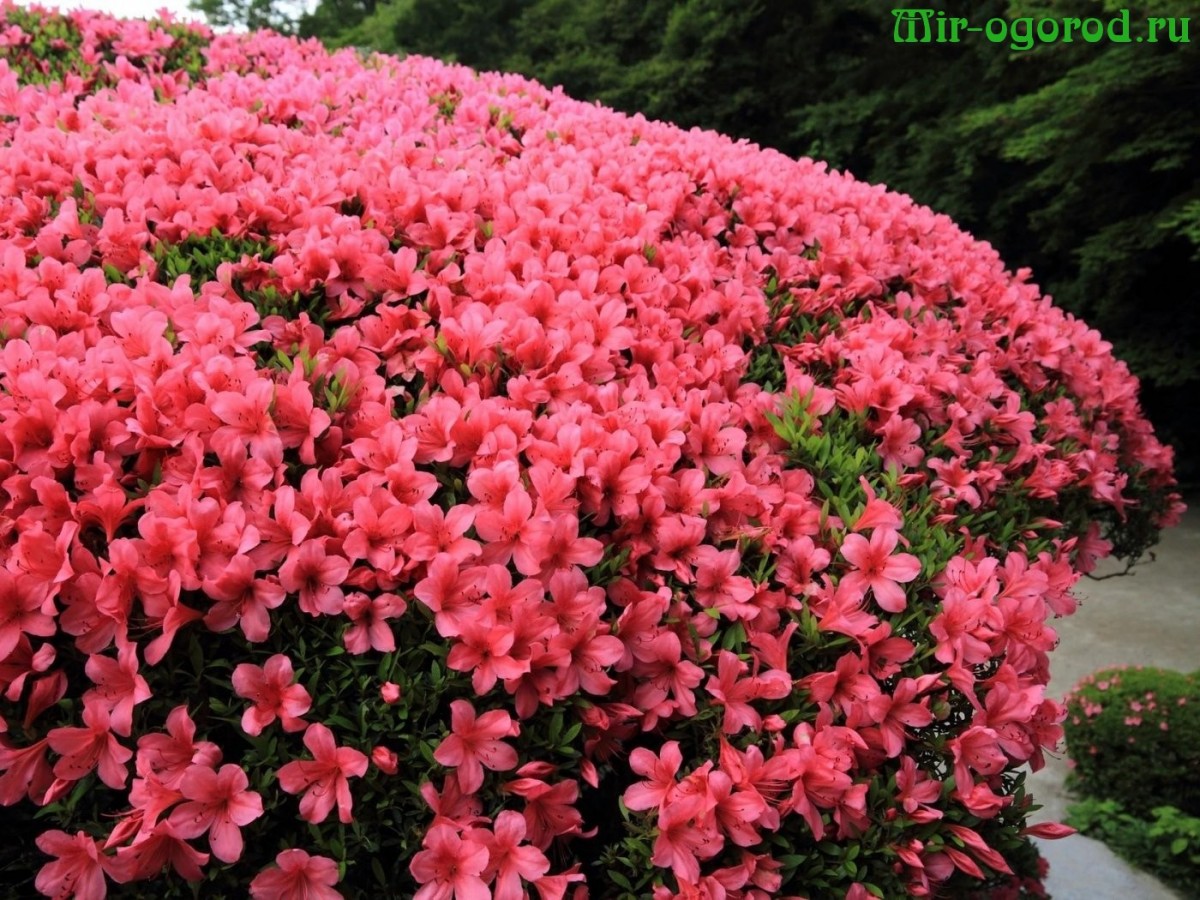
Articles for gardeners
Trimming decorative deciduous shrubs
This group includes types and forms of ornamental shrubs with original foliage, for example: the golden form of black elderberry and Bumald's spirea, Thunberg's barberry, red-leaved forms of hazel, barberry, skumpia, vesicle (kalinifolia spirea) and other plants. In early spring (before the leaves appear), for such shrubs, mainly formative pruning is used, taking into account the growth characteristics of this plant. Usually, old branches are cut at the base of the bush, which are older than 3 years old, weak thickening branches, low horizontally growing branches. If the plant is weak and still young, then radical pruning is used to improve tillering and achieve more magnificent forms. It is recommended to rejuvenate old plants (remove almost the entire upper part, leaving stumps 10-30cm). These include white turf, different varieties willow, elderberry, viburnum vesicle, hazel, maple (shrub forms).
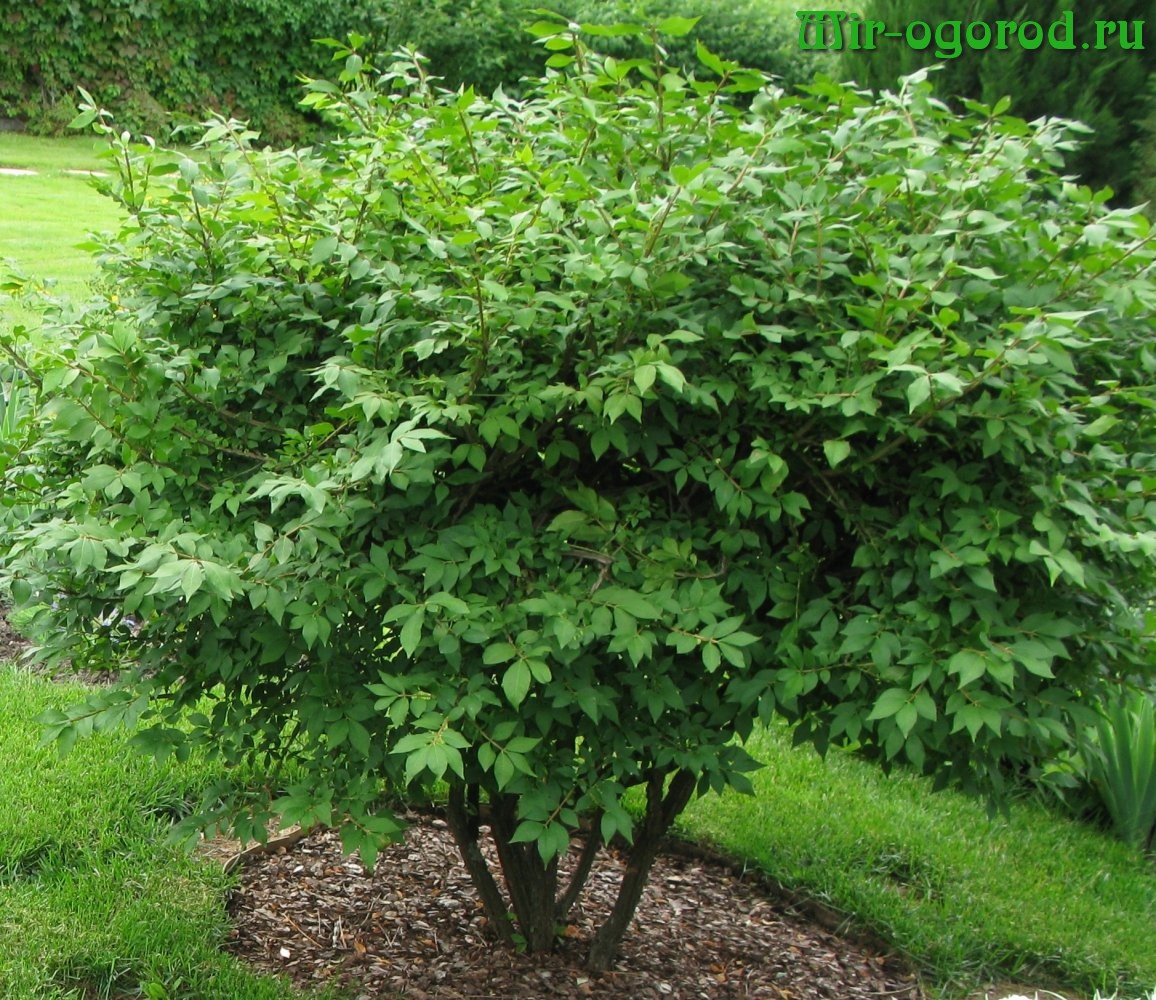
Rules and scheme for pruning ornamental shrubs
The optimal timing for pruning ornamental shrubs is the end of winter - the beginning of spring (from mid-February to mid-April) and the second half of summer, when shoot growth is fully completed. The expediency of pruning during this period is confirmed by experience. Pruning can also be done during the growing season, since callus immediately forms around the cut, but the presence of a large number of leaves makes this operation very difficult. Annual shoots are usually shortened "by the kidney", leaving no stumps that make it difficult to overgrow the cut and reduce the decorative effect of a tree or shrub. The cut should be oblique, it should begin at the level of the middle of the kidney on the opposite side, and end directly above the top of the kidney. With a very low beginning of the cut, the apical bud may dry out or a very weak shoot may appear, which cannot completely replace it and, moreover, enhance the growth of the cut shoot. If the cut is high above the kidney, then the remaining long spike dies off later. The cut must be above a well-developed healthy vegetative (but not flower) bud.
Quite often novice owners suburban areas forget about pruning shrubs, concentrating their attention on watering, top dressing mineral fertilizers and soil composition. However, when the bushes grow and become more voluminous, pruning ornamental shrubs is a must.
Depending on the desired result, the types of pruning shrubs are divided into:
- sanitary pruning;
- forming pruning;
- rejuvenating pruning.
Sanitary pruning
autumn similar view pruning is carried out absolutely for all artisanal plants. The main goal is to prevent the development of infectious processes, as well as the formation of rot, and is characterized by the removal of all broken and damaged branches. Also, to fully ventilate the crown of the bush, you should clean the branches growing inside the plant itself. Unripe branches should be cut with a remainder of 2-3 cm above the bud.
Formative pruning
Autumn formative pruning is used only for shrubs that bloom in summer. In the case of autumn pruning of flowering shrubs in spring period, there is a high probability of deterioration in the decorative appearance, since these bushes bloom on last year's branches.
Dendrologists include such shrubs:
- forsythia;
- Japanese quince;
- all kinds
- full range of weigela;
- lilac;
- all species that bloom with white buds;
- such varieties of almonds as steppe and three-lobed;
- action.
The above shrubs can be cut exclusively for sanitary and anti-aging purposes in the fall.
With the help of formative pruning, a shrub from an ordinary one becomes decorative. To do this, every year, a couple of the strongest shoots should be added to the already existing key branches. Special attention should be given to plants with a large number of root shoots. For example, irga alder-leaved, white snowberry, fieldfare. When forming such shrubs, it is necessary to control the growth in width and cut off most of the root shoots around the perimeter. It is also very important not to allow too dense a crown to develop while the plant is young and actively developing.
But do not overdo it with abundant disposal of shoots, otherwise it can lead to a very loose shrub constitution. Initially, you should get rid of weak branches that are directed away from the roots. Pruning of strong branches is also allowed if they are directed inside the bush or are close to others. good shoots. It is recommended to leave only branches that will eventually be able to replace the old or diseased branch.
Some poorly winter-hardy shrubs may develop dry branches that should be pruned. The most effective and reliable will be a cut over the second kidney. Also, periodically you should get rid of lodging branches that distort the overall perception of the ornamental bush.
In a situation where the upper branches are frozen and the lodging ones are not affected, you can leave them and tie them up with garden twine or make a special frame. After some time, when the bush begins to grow in the designated position, the support can be removed. This method will help the shrub to regain the lost decorative appearance.
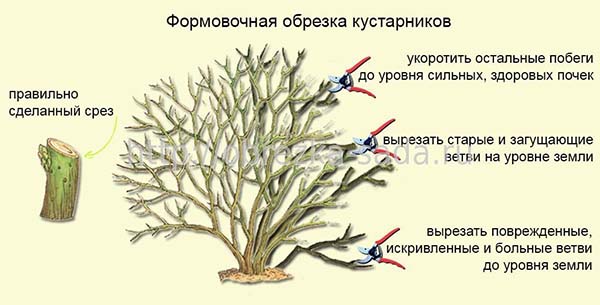
Form pruning ornamental shrubs
Anti-aging pruning
In order to obtain more abundant flowering and ripening of a large number of fruits, on already aged plants, the rejuvenating pruning method is used. This method is also recommended for use on plants whose annual growth is less than 7 cm. this way pruning by activating the growth of dormant or adnexal buds, after the procedure for shortening old branches. The most optimal time for anti-aging pruning is the period from February to April, as well as from August to September.
Branches should be cut about 30% from the top, just after the plant has stopped flowering. Branches that show good lateral growth will become even more luxuriant, and the number of fruits and flowering will increase if one of the three oldest in the bush is removed. This procedure is recommended to be performed every two years, which will not allow the plant to thicken too much and provide the necessary aeration.
Features of anti-aging pruning
Anti-aging pruning can also control the size of the inflorescences. So, in the case of a strong decrease in the length of the branches, the flowers will be larger than with a slight shortening. However, the concentration of flowering on a heavily pruned branch will also decrease. A number of ornamental shrubs, for example, coronal mock orange or action, with regular pruning may lose the splendor of their crown, respectively, selective shoots need to be reduced.
The pruning procedure should be subjected to no more than four buds at a time, which later form strong branches and can replace less popular shoots next year. The bush undergoes complete shortening of the branches only with a significant reduction in flowers, in most cases this is observed 3-4 years after planting.
Also, amateur gardeners need to know about the distinctive features of bushes that bloom on the branches of last year, for example, hawthorn, large-leaved hydrangea, forsythia, and on the shoots of this year: panicled hydrangea, Japanese spirea. In addition, there are a number of ornamental shrubs, the flowering of which in the spring is carried out on the branches of the previous year, and in the summer - already on the branches of the current year. Such plants include weigala and kerria.

When to do anti-aging pruning
Perform anti-aging pruning for more decorative and fruit bushes best in early spring. A signal of the need for this procedure is the appearance of weak shoots and the shrinking of branches. It should be shortened above the branches, located as close as possible to the base of the branch or in a place that is characterized by more powerful growth of the rejuvenated shoot.
Radical rejuvenation
In cases where the shrub has lost the ability to form not only strong branches, but also weaker and shorter ones, it is necessary to resort to a radical rejuvenation procedure. All branches must be cut at ground level, and in a situation where the plant was formed on a stock, cut at a height of 10-15 cm from the location of the graft. Only in this case, the kidneys are activated and will give a new rapid growth, since the volume of the root has remained at the same level. Then, after a season or two, depending on the level of growth of the shrub, it is necessary to remove weak and poorly located branches.
Video "Features of pruning ornamental shrubs"
Proper pruning of ornamental shrubs
How to cut a shrub correctly and not harm it is one of the most common questions that beginner gardeners have. The procedure for competent pruning is not very difficult if you follow the basic recommendations.
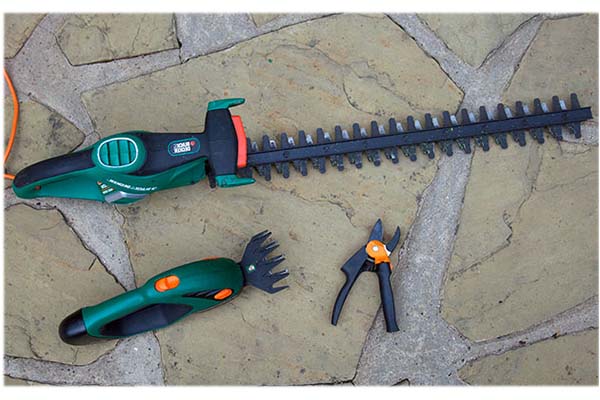
Pruning ornamental shrubs tools
During pruning, you must follow certain rules:
- all dried and broken shoots should be removed immediately;
- hemp and slices should not be split;
- the correct cut, which does not leave a hemp, is carried out at an angle, and not straight;
- the cutting tools used must be well sharpened and always clean;
- you should try to minimize the damage to the cultivated shrub: branches whose thickness is less than or equal to 2 cm are cut with a pruner, and in the case of thicker branches, with a hacksaw;
- in the process of work, it is necessary to act pointwise, try not to hook nearby shoots;
- to stimulate the growth of weak branches, the shoots should be cut shorter, and for healthy and well-growing branches, too much shortening is not required;
- the correct cut is characterized smooth surface and without various scraps of bark. In case of an uneven cut, a garden knife can be used to achieve the desired smoothness;
- do not forget that it is better to pinch the shoot at one time than to cut it off later.
Also, do not forget about care after pruning: all sections are processed with garden pitch, and if the surface thickness is more than 3 cm, the use of oil paint will be much more effective.
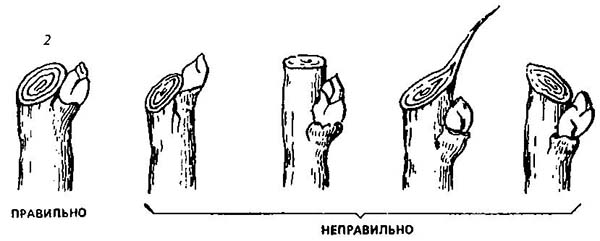
How to make a cut when trimming
Derain is a very fast-growing shrub, capable of constant watering and proper feeding give an increase of up to 1.5 meters.
Often, given plant pruned to form the desired crown shape. AT autumn period all old branches are removed, and in the spring strong vertical shoots will modify the bush. If the goal is to form a round and “shaggy” shrub, in the fall one-year growth should be shortened by several buds. In the spring, this pruning will strengthen the side branch.
Shrub cinquefoil initially has a uniform crown shape; accordingly, it undergoes a pruning procedure only when the plant is deformed.
With full growth, in the autumn, old and damaged branches are removed, and unrooted ones are cut a little.
Formative pruning should be carried out if you want to get more intense flowering. Anti-aging pruning is carried out, in most cases, after the hydrangea reaches 5 years of age.
Old branches are removed almost completely at ground level, it is enough to leave no more than 4-5 shoots. In the spring, young flowering shoots form from the buds located on the root neck, and the remaining old branches will bloom with renewed vigor.
In the case of removing already faded buds at a height of 30-40 cm from ground level, in spring it is possible to achieve an increase in young shoots on strong last year's branches, which will not allow long and flexible branches to bend under the weight of flower caps.
To obtain more blooming lush summer varieties of spirea, the pruning procedure should be carried out in the fall.
The length of the cut depends on the age of the plant:
- for shrubs whose age is more than 10 years, pruning is carried out at ground level. Next spring, new strong branches will appear from the root system, which will also bloom in the prescribed period of time;
- a younger shrub is recommended to thin out a little: old shoots are shortened by 25-30 cm. This pruning will increase the number of lateral buds in spring, which will change the appearance of the bush for the better.
After pruning, the plant should be mulched with a solution of humus or peat, and the roots should be covered from hypothermia.
Video "Pruning an ornamental shrub - spirea"
Organic top dressing after pruning
All plants after pruning should be fed. It doesn’t matter if the branch reduction procedure was performed in the spring or in the fall, only the fertilizers themselves are different.
Spring dressing play big role in the development of the plant, because it is during this period of time that the shrub increases its vegetative mass and restores everything that was lost during the winter. In addition, over time, the concentration of nutrients in the soil gradually decreases.
First of all, it is necessary to supply the soil with nitrogen and potassium trace elements. For this, a solution of potassium nitrate and pure water, mixed in the following proportion: 3 tablespoons of fertilizer per 10 liters of water, is perfect. Solutions of azofosk and nitrophoska and a mixture of 30 g of urea and 100 g of wood ash diluted with a bucket of water.
In the case of pruning a shrub in the period from August to September, the plant experiences an acute shortage of phosphorus fertilizers, because the root system is quite actively formed at this time. For a more uniform achievement of shrub root fertilizers, top dressing should be evenly distributed around the perimeter of the near-stem circle, and the procedure for introducing useful microelements should be combined with watering.
For effective and full-fledged growth, it is recommended to fertilize ornamental and fruit shrubs with infusion. The finished composition will be formed after 2-3 days, and the best proportion is 0.5 kg of compost per 10 liters of water.
Watering the bush should be in the evening, when the heat has already subsided or in cloudy weather. It should not be allowed to get the solution on young branches and leaves, and in case of prolonged drought, trunk circle shrubs should be thoroughly soaked with plain water before using the compost mixture.
As a conclusion, it should be noted that pruning ornamental shrubs is not a complicated procedure and plays a significant role in the formation of healthy and beautiful plants, which will surely reward their owner with lush and beautiful flowering.

